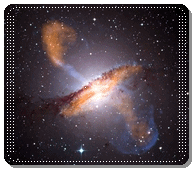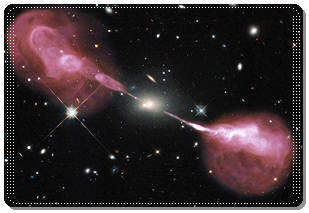
| CONTENT - A example of a active galaxy |
 | The Centaurus A, or Cen A, active galaxy. picture courtesy site 'Amateur Astronomy' |
Also known as NGC 5128, the Centaurus A galaxy, or 'Cen A' is located about 12 million light-years away in the constellation Centaurus, the Centaur, the closest giant galaxy to the Milky Way. Cen A is often the study of professional astronnomers. It was one of the first celestial radio sources identified with a galaxy. It is a giant elliptical galaxy and is one of the closest active galaxies as it might have been created by the cataclysmic collision of two galaxies. Astronomers classify Cen A as a 'active galaxy,' a term applied to any galaxy whose central region exhibits strong emissions at many different wavelengths. What powers these emissions is a black hole 55 millions times more massive than our Sun! A hallmark of radio galaxies is the presence of huge, double-lobed radio-emitting structures around a elliptical galaxy. Cen A is a textbook example of those. The warped shape of Centaurus A's disk of gas and dust is evidence for a past collision and merger with another galaxy. The resulting shockwaves cause hydrogen gas clouds to compress, triggering a firestorm of new star formation. The center of the galaxy is home for a supermassive black hole that ejects jets of high-speed gas into space. Jets of superheated gas moving at close to the speed of light, generally, have long been associated with the cores of giant elliptical galaxies, and galaxies in the process of merging. A growing class of unusual spirals with intense radio jets, on a other hand, continues to raise significant questions about how jets are produced within galaxies, and how they are thrown out into the cosmos
As the 10-million solar masses black hole somehow diverts some of the matter falling toward it into two oppositely directed jets that stream away from the center as those magnetized particle jets moving near the speed of light. Those jets interact with the surrounding interstellar matter, but also the galaxy's intensely active nucleus, and its large gaseous halo. Over the course of tens of millions of years, these jets puffed out two giant bubbles filled with magnetic fields and energetic particles -- the radio lobes we now see. The radio waves arise as high-speed electrons spiral through the lobes' tangled magnetic fields. Those giant radio-emitting lobes are stretching more than 1.4 million light-years. If our eyes could see radio waves, Centaurus A would be one of the biggest and brightest objects in the sky, nearly 20 times the apparent size of a full moon. Lobes are filled with matter streaming from particle jets as matter near the base of these jets races outward at about one-third the speed of light, through processes not fully understood. Jet at times possibly are changing the galaxy's rate of star formation
 | The Centaurus A galaxy seen with its jets and radio lobes; each jet has a span 4.16 light-years wide. picture site 'Amateur Astronomy' based on a picture ESO/WFI (visible), MPIfR/ESO/APEX/A.Weiss et al. (microwave) et NASA/CXC/CfA/R.Kraft et al. (X-ray) |
And that's not all! A study in 2010 have shown that the radio lobes of Cen A are gamma-ray output is more than ten times greater than their radio output. If gamma-ray telescopes had matured before their radio counterparts, astronomers would have instead classified Cen A as a 'gamma-ray galaxy.' The gamma rays, which are the highest-energy form of light, seen at Centaurus A are manufactured like because the entire universe is filled with low-energy radiation or radio photons from the all-pervasive cosmic microwave background, as well as infrared and visible light from stars and galaxies. When one of these photons collides with a super-fast particle in the radio lobes of the galaxy, the photon receives such an energy boost it becomes a gamma ray. This is a process called inverse Compton scattering and a common way of making cosmic gamma rays. In dozens of active galaxies, this process has been shown to produce X-rays. But the Cen A study marks the first case where astronomers have solid evidence that microwave photons can be kicked up to gamma-ray energies. A other study also observed a higher-energy radiation still from Cen A's central region, billions of times more energetic than the radio waves emitted as where it originates remains a mystery
A other example of a powerful radio galaxy is elliptical galaxy Hercules A or 3C 348. Spectacular jets from the supermassive black hole in the core are ejected from that galaxy which is roughly 1,000 times more massive than the Milky Way and harbors a 2.5-billion-solar-mass central black hole that is 1,000 times more massive than the black hole in the Milky Way. The galaxy is one of the brightest extragalactic radio sources in the entire sky. Such radio-emitting galaxies usually are not found in a large cluster of galaxies, but rather within a comparatively small group of them. The black hole is spewing out strong jets of energetic particles that produce enormous lobes of radio emission. The size of these radio lobes dwarfs the large galaxy and extends throughout the volume of the galaxy group. Jets of Hercules A are one-and-a-half million light-years wide each, very-high-energy plasma beams, subatomic particles and magnetic fields shot at nearly the speed of light from the vicinity of the black hole. The outer portions of both jets show unusual ring-like structures suggesting a history of multiple outbursts from the black hole. Innermost parts of the jets are not visible because of the extreme velocity of the material, which causes relativistic effects that beam the light away from us. Far from the galaxy, the jets become unstable and break up into the rings and wisps. The entire radio source is surrounded by a very hot, X-ray-emitting cloud of gas, not seen in this optical-radio composite below. Hercules A also features a companion elliptical galaxy very close to the center of the optical-radio source, which may be merging with the central galaxy. Several other elliptical and spiral galaxies are found in the surroundings and may be members of a cluster of galaxies
 | The Hercules A galaxy is a larger radio galaxy still in the Universe! picture site 'Amateur Astronomy' based on a picture NASA, ESA, S. Baum and C. O'Dea (RIT), R. Perley and W. Cotton (NRAO/AUI/NSF), and the Hubble Heritage Team (STScI/AURA) |